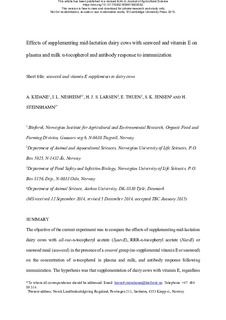| dc.contributor.author | Kidane, Alemayehu | |
| dc.contributor.author | Nesheim, Ingvild Luteberget | |
| dc.contributor.author | Larsen, Hans J. | |
| dc.contributor.author | Thuen, Erling | |
| dc.contributor.author | Jensen, Søren Krogh | |
| dc.contributor.author | Steinshamn, Håvard | |
| dc.date.accessioned | 2017-12-18T13:08:03Z | |
| dc.date.available | 2017-12-18T13:08:03Z | |
| dc.date.created | 2015-05-27T13:25:17Z | |
| dc.date.issued | 2015-03-18 | |
| dc.identifier.citation | Journal of Agricultural Science. 2015, 153 (5), 929-942. | nb_NO |
| dc.identifier.issn | 0021-8596 | |
| dc.identifier.uri | http://hdl.handle.net/11250/2472521 | |
| dc.description.abstract | The objective of the current experiment was to compare the effects of supplementing mid-lactation dairy cows with all-rac-α-tocopheryl acetate (SyntvE), RRR-α-tocopheryl acetate (NatvE) or seaweed meal (Seaweed) in the presence of a Control group (no supplemental vitamin E or seaweed) on the concentration of α-tocopherol in plasma and milk, and antibody response following immunization. The hypothesis was that supplementation of dairy cows with vitamin E, regardless of its form, would increase plasma and milk α-tocopherol compared to the control diet and this incremental response would be bigger with NatvE than SyntvE. Furthermore, it was hypothesized that vitamin E, regardless of its form, will provide an improved adaptive immune response to immunization than the Control diet, and cows supplemented with Seaweed meal would produce better adaptive immune response following immunization than cows in the Control group. Twenty-four Norwegian Red (NR) dairy cows in their mid-lactation were allocated randomly to the four treatments in a replicated Latin square design. The cows were fed on a basal diet of silage and concentrate on top of which the experimental supplements were provided. Plasma and milk α-tocopherol concentrations were higher in NatvE and SyntvE groups than in the other two groups. The RRR-α-tocopherol stereoisomer was the predominant form (>0·86), in both plasma and milk, whereas the remaining part was largely made up of the other three 2R stereoisomers (RRS, RSR and RSS). In cows fed the Control, Seaweed and NatvE, the proportion of the RRR-α-tocopherol stereoisomer in plasma and milk constituted >0·97 of the total α-tocopherol. Mid-lactation NR dairy cows had higher than adequate levels of plasma α-tocopherol (9·99 mg/l) even when not supplemented with external source of vitamin E, suggesting that with a good quality silage these cows may not be at risk of vitamin E deficiency. Furthermore, the present study shows that dairy cows in mid to late lactation have preferential uptake of RRR stereoisomer of α-tocopherol compared with other stereoisomers. All cows responded well to immunization with different antigens, but there were no significant group effects of the diet on the immune response measured. | nb_NO |
| dc.language.iso | eng | nb_NO |
| dc.publisher | Cambridge University Press | nb_NO |
| dc.title | Effects of supplementing mid-lactation dairy cows with seaweed and vitamin E on plasma and milk α-tocopherol and antibody response to immunization | nb_NO |
| dc.type | Journal article | nb_NO |
| dc.type | Peer reviewed | nb_NO |
| dc.description.version | acceptedVersion | nb_NO |
| dc.rights.holder | © Cambridge University Press 2015 | nb_NO |
| dc.source.pagenumber | 929-942 | nb_NO |
| dc.source.volume | 153 | nb_NO |
| dc.source.journal | Journal of Agricultural Science | nb_NO |
| dc.source.issue | 5 | nb_NO |
| dc.identifier.doi | 10.1017/S0021859615000052 | |
| dc.identifier.cristin | 1244687 | |
| dc.relation.project | Norges forskningsråd: 190301 | nb_NO |
| cristin.ispublished | true | |
| cristin.fulltext | postprint | |
| cristin.qualitycode | 1 | |
